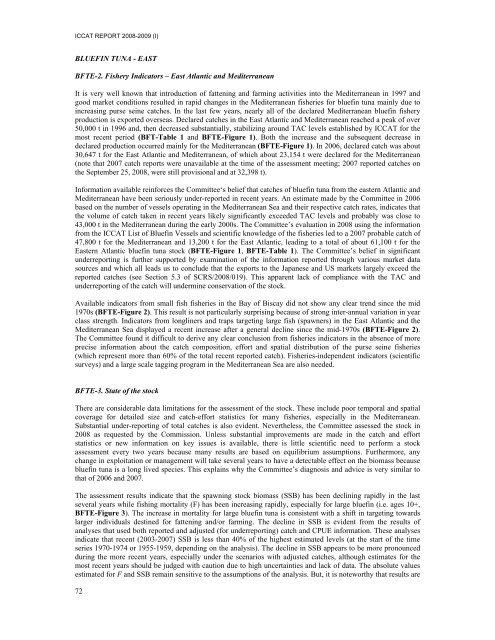REPORT OF THE STANDING COMMITTEE ON RESEARCH ... - Iccat
REPORT OF THE STANDING COMMITTEE ON RESEARCH ... - Iccat
REPORT OF THE STANDING COMMITTEE ON RESEARCH ... - Iccat
Create successful ePaper yourself
Turn your PDF publications into a flip-book with our unique Google optimized e-Paper software.
ICCAT <strong>REPORT</strong> 2008-2009 (I)BLUEFIN TUNA - EASTBFTE-2. Fishery Indicators – East Atlantic and MediterraneanIt is very well known that introduction of fattening and farming activities into the Mediterranean in 1997 andgood market conditions resulted in rapid changes in the Mediterranean fisheries for bluefin tuna mainly due toincreasing purse seine catches. In the last few years, nearly all of the declared Mediterranean bluefin fisheryproduction is exported overseas. Declared catches in the East Atlantic and Mediterranean reached a peak of over50,000 t in 1996 and, then decreased substantially, stabilizing around TAC levels established by ICCAT for themost recent period (BFT-Table 1 and BFTE-Figure 1). Both the increase and the subsequent decrease indeclared production occurred mainly for the Mediterranean (BFTE-Figure 1). In 2006, declared catch was about30,647 t for the East Atlantic and Mediterranean, of which about 23,154 t were declared for the Mediterranean(note that 2007 catch reports were unavailable at the time of the assessment meeting; 2007 reported catches onthe September 25, 2008, were still provisional and at 32,398 t).Information available reinforces the Committee‘s belief that catches of bluefin tuna from the eastern Atlantic andMediterranean have been seriously under-reported in recent years. An estimate made by the Committee in 2006based on the number of vessels operating in the Mediterranean Sea and their respective catch rates, indicates thatthe volume of catch taken in recent years likely significantly exceeded TAC levels and probably was close to43,000 t in the Mediterranean during the early 2000s. The Committee’s evaluation in 2008 using the informationfrom the ICCAT List of Bluefin Vessels and scientific knowledge of the fisheries led to a 2007 probable catch of47,800 t for the Mediterranean and 13,200 t for the East Atlantic, leading to a total of about 61,100 t for theEastern Atlantic bluefin tuna stock (BFTE-Figure 1, BFTE-Table 1). The Committee’s belief in significantunderreporting is further supported by examination of the information reported through various market datasources and which all leads us to conclude that the exports to the Japanese and US markets largely exceed thereported catches (see Section 5.3 of SCRS/2008/019). This apparent lack of compliance with the TAC andunderreporting of the catch will undermine conservation of the stock.Available indicators from small fish fisheries in the Bay of Biscay did not show any clear trend since the mid1970s (BFTE-Figure 2). This result is not particularly surprising because of strong inter-annual variation in yearclass strength. Indicators from longliners and traps targeting large fish (spawners) in the East Atlantic and theMediterranean Sea displayed a recent increase after a general decline since the mid-1970s (BFTE-Figure 2).The Committee found it difficult to derive any clear conclusion from fisheries indicators in the absence of moreprecise information about the catch composition, effort and spatial distribution of the purse seine fisheries(which represent more than 60% of the total recent reported catch). Fisheries-independent indicators (scientificsurveys) and a large scale tagging program in the Mediterranean Sea are also needed.BFTE-3. State of the stockThere are considerable data limitations for the assessment of the stock. These include poor temporal and spatialcoverage for detailed size and catch-effort statistics for many fisheries, especially in the Mediterranean.Substantial under-reporting of total catches is also evident. Nevertheless, the Committee assessed the stock in2008 as requested by the Commission. Unless substantial improvements are made in the catch and effortstatistics or new information on key issues is available, there is little scientific need to perform a stockassessment every two years because many results are based on equilibrium assumptions. Furthermore, anychange in exploitation or management will take several years to have a detectable effect on the biomass becausebluefin tuna is a long lived species. This explains why the Committee’s diagnosis and advice is very similar tothat of 2006 and 2007.The assessment results indicate that the spawning stock biomass (SSB) has been declining rapidly in the lastseveral years while fishing mortality (F) has been increasing rapidly, especially for large bluefin (i.e. ages 10+,BFTE-Figure 3). The increase in mortality for large bluefin tuna is consistent with a shift in targeting towardslarger individuals destined for fattening and/or farming. The decline in SSB is evident from the results ofanalyses that used both reported and adjusted (for underreporting) catch and CPUE information. These analysesindicate that recent (2003-2007) SSB is less than 40% of the highest estimated levels (at the start of the timeseries 1970-1974 or 1955-1959, depending on the analysis). The decline in SSB appears to be more pronouncedduring the more recent years, especially under the scenarios with adjusted catches, although estimates for themost recent years should be judged with caution due to high uncertainties and lack of data. The absolute valuesestimated for F and SSB remain sensitive to the assumptions of the analysis. But, it is noteworthy that results are72
















